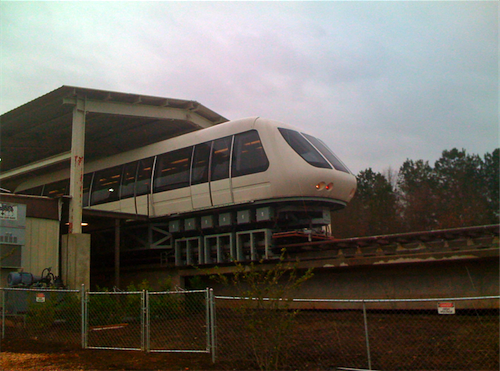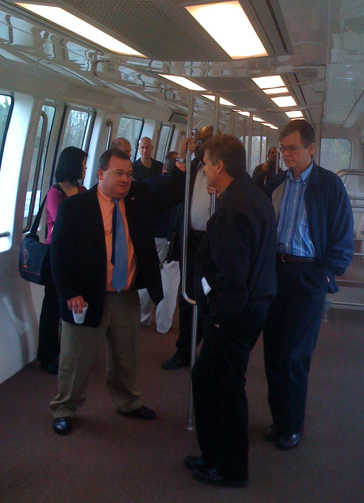
Jeff Foxworthy said once, “If the directions to your place include the phrase ‘Turn off the paved road,’ you might be a redneck.”
I’m not sure if American Maglev would appreciate the comparison, but it’s apt. A little ways off Thornton Road in Powder Springs, about twenty miles west of Atlanta, down an unpaved road, is a glimpse of the future. I got a chance to visit them yesterday.
“Magnetic levitation” is one of those delightful polysyllabic phrases. It’s routinely invoked in science fiction books and films to connote swoopy futuristic trains hurtling across the landscape at hundreds of miles per hour.
But in the pine woods of this Atlanta suburb, Tony Morris (a Georgia Tech graduate) and his team have built a reasonably-swoopy train car and a third of a mile of elevated trackway. A lot of money has been spent here… nearly $50 million over the life of the company. The latest investors are from Dubai.
And the darned thing works.
Maglevs are cool for lots of reasons. By floating the car over the rail, you eliminate friction. No wheels, no bearings. By inducing eddy currents in the track, the car becomes part of a linear induction motor that’s as long as the track. No rotary motors, no gearing, nothing to lubricate. By using electricity as your motive power, you have no local emissions… and if those electrons are coming from nuclear or solar or hydro plants, no emissions at all. And there’s not even much noise to complain about.
In science fiction, maglevs require superconducting magnets. Superconductors come in two flavors: high-temperature and low-temperature. “High” temperature is a relative term — these are cooled by liquid nitrogen at minus-320°F, so they’re still awfully cold to you and me. But liquid nitrogen is cheap… about the same cost per liter as beer. Unfortunately, high-temp superconductors are pretty lousy from an engineering viewpoint. Hard to work with, brittle, low current densities — not a good answer.
Low-temperature superconductors are cooled by liquid helium. Liquid helium costs more per liter than Glenmorangie. And it boils off and has to be replaced constantly. And keeping anything cooled to minus-452°F means massive engineering challenges. So maglevs based on low-temperature superconductors are horrendously expensive.
American Maglev has declared “a plague on both your houses” and isn’t using superconductors at all. Just honking big electromagnets (like the ones in your radio speakers, but bigger) with a sophisticated sensor and control system. This system monitors the gap between the magnets and the rail thousands of times per second, adjusting the electromagnet drive current as necessary to maintain a constant 3/8-inch separation.
The team’s mantra is “smart vehicle, stupid track.” This makes a lot of sense. The track is elevated (keeping it out of the path of kids, cows, or cars) and consists of two load-bearing steel rails, two more steel rails to carry the electric current, and a series of flat aluminum plates down the middle. It’s supported by pre-cast concrete towers every 88 feet… meaning that building a track means digging sixty deep holes per mile and snapping pieces together, rather than the laborious bulldozer, grading, filling, and paving process needed for traditional light rail (trolleys) or heavy rail (MARTA or Amtrak).
Levitating the car only requires 40 kilowatts (50 horsepower) of power; about the same as two dozen hair-dryers. Making it go sucks more current, but you get some of it back when slowing down (by charging on-board batteries). Overall, the company claims to be able to transport passengers and freight for approximately 1/3 the power of steel wheels on steel rails.
Inside, the car feels like a five-fourths-scale model of a MARTA car. It’s about two feet wider inside and a bit taller, which makes it feel much more spacious. There’s plenty of room for various seating arrangements, or even carving it into compartments if required. The current car would seat 100, or allow 200 to stand at American densities, or allow over 300 to stand at Tokyo density.
There’s no driver; everything is computer-controlled. For long-haul routes, the company expects there to be an attendant of some sort in each car to make passengers feel more comfortable (and probably to sell snacks and Cokes). For urban routes, we’ll probably be on our own — just like the underground trains at Hartsfield.
I’ve written elsewhere about the advantages of private vehicles over mass transit. But, if we’re going to have mass transit, can’t it at least be good mass transit?
MARTA claims that it can build new heavy rail for $200 million per mile. They’re probably wrong; the Los Angeles Red Line cost an eye-popping $700 million per mile in current dollars. (For the math-impaired, that’s over $11,000 per inch.)
American Maglev claims they can build their system for $20 million per mile. Even if they’re optimistic, that’s startlingly less than heavy rail. It’s even less than light rail… and, because American Maglev’s vehicles travel on an elevated track, they don’t have to be hardened against collisions with cars and trucks like trolleys… which means the swoopy levitating vehicle will actually be cheaper than old-fashioned electric streetcars.
Smart software means that, instead of an eight-car MARTA train controlled by a trained operator, you can have a bunch of single cars running more frequently. I don’t know about you, but the statistical indeterminacy of how long I’ll have to wait for a MARTA train is one factor in why I don’t use transit much. If I knew there’d be another car along every two minutes, I wouldn’t care so much.
American Maglev’s test track in Powder Springs is their third generation of technology, but they intentionally kept a low profile until late last year. Now that they have working hardware, they’re hosting frequent delegations of potential customers from around the world. They’re bound to win one or more of the projects they have bid on, from Los Angeles to Asia. Personally, I think it’d be great if they convinced the Atlanta Beltline folks to go with maglev!
I visited yesterday as part of a delegation from Georgia Tech. I appreciate the time that Tony and his team took to demonstrate the system and answer our questions. We had a great time, and I’m thrilled to see this unexpected new player in Atlanta’s high-tech community.
Nice post Stephen!
It is great to hear that there is some real work being done in this area by an American Company. They seem to have addressed some of the key issues in terms of cost and it would be great to see them win a few contracts and gain support for their product. Maglevs have been around for a long time and it has always surprised me that the US has not been able to make effective use of this technology. One argument has always been the cost and the fact that they are good for long distance routes. At $20MM/mile compared to the $200MM/mile claim from MARTA it seems like this alternative that should be given serious consideration. While American Maglev has kept a low profile as they have built out their concept and prototype, it is probably time that they started generating some mainstream media awareness. A thorough cost analysis could perhaps be published as a White Paper to validate their product and garner some genuine support.Let’s hope that we can be riding in these Maglevs here in Atlanta in the near future.
LACMTA Redline is all underground. Will the MARTA extension be that way as well?
All I have to say to this is…wow.
That is a pretty amazing opportunity growing practically in your back yard. I have always wanted to see a maglev train. I thought there was only a few around. I had no clue there was one in America.
I claim that you are lucky to have seen this.
Methinks someone is “cooking the books” when it comes to the data.
From:http://www.brooklynrail.net/science_of_railway_locomotion.html
We can find a reference to a 30 HP engine hauling a 70 Ton train at 20 mph on level track.
How heavy is the car levitated with 50 HP ? And how fast? What’s the friction from the electrical connection?
And the cost for steel rail track is not $200 – 700 M per mile for 79 MPH signaled track, but more in the range of $5 – 7M per mile. Perhaps they are adding in the cost to acquire the right of way.
http://www.wral.com/news/local/story/7582696/
“If you’re looking to build a mile of interstate highway, you’re looking anywhere from $30 million to $50 million a mile. So, building a rail operation at $5 million a mile is a pretty good deal,” he said.